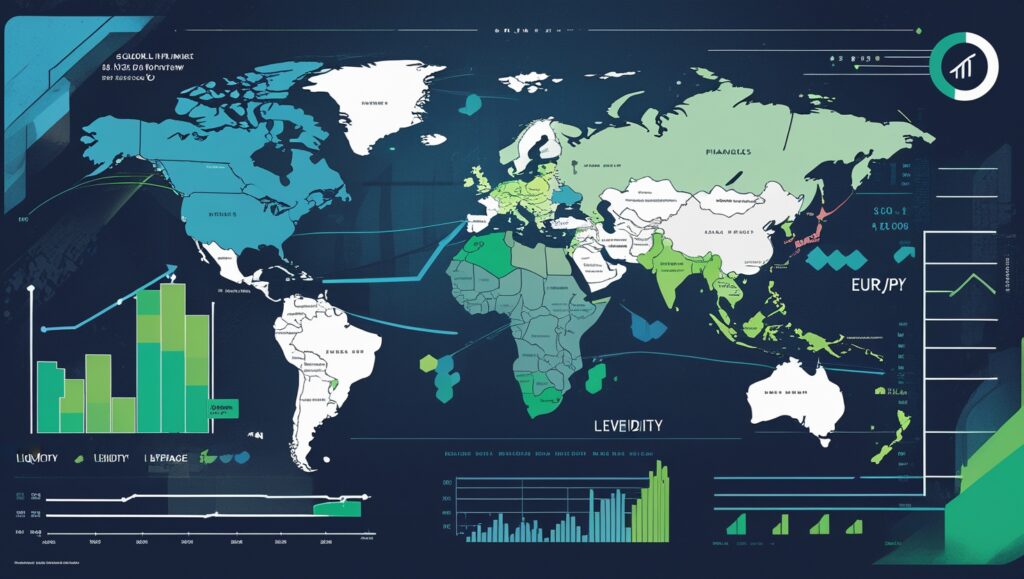
Investors often search for top 100 penny stocks hoping to find explosive growth opportunities with a small outlay. However, penny stocks (typically shares under a few dollars, often under 10¢) are highly speculative and come with unique perils. In contrast, the global forex (foreign exchange) market is the world’s largest financial market, offering high liquidity and 24/5 trading. This beginner-friendly guide compares penny stocks and forex on both short-term and long-term bases. We’ll examine their advantages and risks, cite real 2025 examples of sub-$0.10 penny stocks, and contrast them with major currency pairs. Along the way, expert analysts’ insights (for example, Motley Fool CEO Tom Gardner) highlight key lessons.
Overview: Top 100 Penny Stocks vs Forex
| Penny Stocks vs Forex Market: Comprehensive Investment Comparison | ||
|---|---|---|
| Investment Characteristics | Top 100 Penny Stocks | Global Forex Market |
| Market Definition |
Stocks typically under $5, often under $0.10
Micro-cap companies on OTC markets Limited SEC reporting requirements |
World’s largest financial market
Daily volume: $7+ Trillion 24/5 global trading across time zones |
| Risk Level |
EXTREMELY HIGH
“Penny stocks aren’t investing. They’re gambling” – Tom Gardner, Motley Fool CEO
|
HIGH (due to leverage)
Highly regulated and transparent Information readily available |
| Liquidity |
VERY LOW
Thin trading volumes Wide bid-ask spreads Difficult to exit at desired prices |
EXTREMELY HIGH
Instant execution on major pairs Tight spreads Large orders barely move market |
| Real Examples (Sept 2025) |
ADAP: $0.04 → Target $1.35 (3,080% upside)
WINT: $0.07 → Target $350 (472,873% upside)
CRCW: $0.0046 (2.22% daily swing)
⚠️ Targets often reflect hype, not realistic valuation
|
EUR/USD: ~1.05 → Forecast 1.09 (modest 4% move)
Major pairs: Typically 1-3% moves on big news
💡 Leverage amplifies small percentage moves
|
| Short-Term Trading |
✅ Massive % gains possible (100%+ in hours)
✅ Less institutional competition
❌ Extreme volatility and whipsaw moves
❌ Liquidity traps – can’t exit easily
❌ Pump-and-dump schemes common
|
✅ Extreme liquidity for instant trades
✅ 24-hour market opportunities
✅ Multiple strategy options
❌ Leverage can wipe out accounts quickly
❌ Geopolitical shocks cause spikes
|
| Long-Term Outlook |
POOR for most stocks
Most remain low-value or go bankrupt Rare success stories (Amazon, Apple origins) Not suitable for buy-and-hold |
LIMITED appreciation
Currencies tend to mean-revert Range-bound over decades Not traditional long-term investment |
| Information Transparency |
VERY LIMITED
Scarce financial data No major exchange listings Extra research needed to avoid scams |
EXCELLENT
Regular economic data releases Central bank transparency Widespread analysis available |
| Beginner Recommendation |
Tom Gardner: “Beginners should avoid stocks under $10 altogether”
Only use small % of portfolio for speculation
|
Start with demo accounts
Focus on major pairs (EUR/USD, GBP/USD) Learn leverage management Better structure for learning trading
|
| Expert Verdict |
“More gambling than investing”
Suitable only for: Speculation with money you can lose Avoid for core portfolio |
“Measured trading approach”
Suitable for: Short-term trading strategies Can complement diversified portfolio |
Top 100 Penny Stocks: Definition, Allure, and Risks
Penny stocks are usually shares of micro-cap companies trading at very low prices (often under $5, and sometimes under $0.10). They attract investors looking for “cheap stocks to buy now” because even a small capital can control many shares. For example, as of September 2025, biotech Adaptimmune Therapeutics (NASDAQ:ADAP) traded around $0.04 – an entry cost that seems tantalizingly low. Analyst consensus targets even implied potential gains in the thousands of percent (ADAP had a $1.35 target, ~3,080% above its price). Similarly, Windtree Therapeutics (NASDAQ:WINT) was ~$0.07 with a consensus target of $350 (an 472,873% potential upside). These examples illustrate why some investors search for “top 100 penny stocks under 10 cents” as hidden gems with massive upside.

However, penny stocks are notoriously risky. Many trade “over-the-counter” (OTC) and lack SEC reporting requirements. Information is often scarce or unreliable. As Nasdaq notes, penny stocks are “much riskier than blue-chip or large-cap stocks” and “more prone to volatility”, since OTC markets have less transparency and lower trading volume. The thin trading volume means bids and asks can be far apart, so selling shares at your desired price is difficult. In practice, small trades or rumors can trigger huge price swings. For instance, The Crypto Company (OTC:CRCW) – essentially a shell consulting firm – was priced at just $0.0046 on Sept 8, 2025, yet even this tiny price rose 2.22% intraday due to volatility.
Accordingly, experts warn that penny stocks are more like gambling than investing. Motley Fool CEO Tom Gardner bluntly advises that “penny stocks aren’t investing. They’re gambling”. In a 2025 interview he even suggested beginners avoid stocks under $10 altogether. He notes a low share price often signals a troubled business – one perhaps years from profitability or in financial free-fall. Indeed, the chance of hitting a multi-bagger penny is tiny compared to the risk of losing your stake. As Business Insider puts it, penny stocks are “lucrative but high-risk investments: volatile, illiquid, and often subject to scams”. Misleading pump-and-dump schemes remain common. In summary, the enticing allure of a cheap entry (nobody minds buying shares for cents) is offset by major risks: fraud, dilution (many small companies issue new shares heavily), and a likelihood that most such stocks never become big winners.
- Penny Stocks:
- Low price entry (can “buy the stock of your dreams” cheaply), but usually represents a microcap company.
- High volatility: Few sellers/buyers means sharp swings – big gains or losses can happen quickly.
- Information scarcity: Most aren’t on major exchanges; financial data is limited. You must do extra research to avoid scams.
- Extreme outcomes: A few can skyrocket (e.g. early-stage Amazon/AAPL), but statistically most lose value.
- Low price entry (can “buy the stock of your dreams” cheaply), but usually represents a microcap company.
Top 100 Penny Stocks Under 10 Cents: Examples of Cheap Stocks to Watch
When scanning “cheap stocks to buy today,” penny stock lists highlight companies like those above (ADAP, WINT, CRCW) with miniscule prices. Adaptimmune (ADAP) exemplifies a penny biotech: at $0.04 its market cap was only ~$10.9 million, yet analysts pegged a $1.35 price target (implying ~30× gain). Windtree (WINT), at $0.07, had a mind-boggling $350 target. These “cheap stocks” are often in niche sectors (biotech, cannabis, crypto tech) where few analysts cover them. Sometimes heavy buy/sell walls can be overwhelmed by a single trader (“a whale”), causing big jumps or crashes.
However, note that consensus targets in penny stock screens can be wildly optimistic (often reflecting wishful thinking). For instance, Vincerx Pharma (NASDAQ:VINC) at $0.04 had a price target of $40 (nearly 90,000% above!), illustrating hype more than plausible valuation. In short, these names could soar, but they could also become worthless. No reputable expert guarantees these picks. Even “Top 100 penny stocks” lists emphasize how cheap they are, but remind readers: most penny stocks are speculative. As one Nasdaq analyst summary points out, “getting rich on penny stocks is even more uncommon”.
Investors looking at “cheap stocks to buy now” should therefore approach penny stocks with caution. It’s wise to set strict limits: only commit what you can afford to lose, and always diversify. As Tom Gardner said, having 5,000 shares of a $1 stock is not inherently better than one share of a blue-chip worth thousands.
Global Forex Market Overview: Liquidity, Leverage, and Major Pairs
The forex (FX) market, by contrast, is the exchange of world currencies – an entirely different asset class. It is huge and extremely liquid. In fact, forex trading is the largest financial market in the world; average daily volume has exceeded $7 trillion (as of 2022). It operates 24 hours a day (five days a week) across global time zones. Major currency pairs (e.g. EUR/USD, USD/JPY, GBP/USD, USD/CHF) dominate trading. Most FX quotes always involve the U.S. dollar (the primary reserve currency) versus others.

For beginners, the key features of forex include:
- High Liquidity: Unlike penny stocks, each major currency pair sees constant action from banks, institutions, and retail traders. Even huge orders move the market only slightly. RBC Capital Markets notes that major pairs like EUR/USD will generally move in a tight range – e.g. a forecast for end-2025 puts EUR/USD around 1.09 (from ~1.05 earlier), a relatively modest move in percent terms.
- Leverage: Forex brokers typically offer high leverage (sometimes 50:1 or more), meaning you only need ~2% margin to control a position. This “amplifies” returns and losses. Investopedia explains a $100 forex investment could return 50% in minutes if the market moves favorably. By contrast, penny stock trades often have lower leverage (many brokers don’t allow huge margin on OTC stocks).
- Regulation and Transparency: Major currencies are highly regulated through central banks and global financial oversight. Exchange rates and economic data (inflation, employment, GDP) are published routinely, so information is widespread. As Investopedia notes, “the forex market is tightly regulated… and information regarding the various currencies traded is freely and easily available”. This is in stark contrast to penny stocks.
- Steady Trends: Over the long run, currencies move according to macro fundamentals (interest rates, trade flows). For example, if the U.S. economy grows faster than Europe’s, USD might strengthen slightly against EUR. Major pair swings are usually measured in single-digit percentage points per year, not orders-of-magnitude. This makes forex less prone to the lottery-like gains of penny stocks, but also generally less explosive.
In summary, forex offers global scale and stability, whereas penny stocks offer small-scale speculation. There is almost no overlap: penny stocks come from company risk, whereas forex is macro risk. Both markets attract traders, but typically with different mindsets:
- Penny stocks appeal to speculators hunting “the next home run stock” on little capital.
- Forex appeals to traders betting on economic trends and capitalizing on leverage in a liquid market.
Comparing Short-Term Opportunities
In the short term (trading over days to weeks), both markets can deliver big moves – but in very different ways. Penny stocks, with low float and volatility, can leap or plummet dramatically on news. A rumor of a drug approval could send a biotech penny stock 100% up in hours, or a disappointing quarter could erase most of its value in a day. For example, ADAP’s 3.66% intraday change is modest compared to how some tiny biotechs have jumped 200–300% on positive news (though with risk of equally swift reversals).
Forex short-term moves tend to be smaller in percentage terms. Major pairs might swing 1–3% on a big central bank decision or employment report. (Exotic pairs can swing more but with less liquidity.) However, leverage means those few percent moves can still be lucrative. FX trading often uses technical setups: breakouts, trends, or news trades. But as RBC analysts emphasize, these moves usually have upper limits – e.g. expecting EUR/USD to only reach ~1.09 by year-end.
Advantages of short-term penny stock trading:
- Massive percent moves possible: a $0.05 stock rising to $0.10 is +100%.
- Less competition from big institutions (because funds mostly avoid tiny OTC names).
Risks: Bullets:
- Whipsaw volatility: One tiny trade or even a failed pump can crash the price.
- Liquidity traps: You may not be able to exit your position at a good price if few buyers exist.
Advantages of short-term forex trading:
- Extreme liquidity: You can often enter/exit instantly with large volume.
- Variety of strategies: Scalping, news trading, carry trades (earn interest rate differentials), etc.
- Continuous market: The 24-hour nature means opportunities any time.
Risks:
- Leverage risk: Even a 1% adverse move can wipe out an account if highly leveraged.
- Geopolitical shocks: Surprising events (elections, wars) can cause spikes (e.g. sudden JPY/JUA moves).
As one expert summary notes, penny stocks and forex share little in common except risk. Penny stocks’ risk stems from speculation and ignorance; forex risk comes from leverage and macro uncertainty. A balanced short-term trader might prefer forex for its liquidity and structure, while a gambler might chase penny stock swings. But even seasoned traders caution: never put all your trading funds into a single penny stock. As Tom Gardner advised, novices should focus on well-known equities rather than jumping into sub-$1 bets.
Comparing Long-Term Perspectives
Over years, the markets diverge even more. Penny stocks are generally poor long-term investments. Studies show that most small-cap and OTC firms do not sustain growth; many go bankrupt or remain stagnant. The earlier Nasdaq analysis reminds us that famous companies like Amazon and Apple started cheap, but those are rare outcomes. Instead, the majority of penny stocks remain just that – low-price, low-value stocks. Long-term investors typically avoid them unless they somehow evolve into mid-cap companies.
By contrast, forex is not really a “long-term investment” in the traditional sense. You don’t buy and hold a currency for decades expecting it to appreciate like a stock. Currencies are relative: holding one currency is effectively short another. Over the long haul, most currency returns net out: for example, if inflation and interest rates in two countries remain in line, the exchange rate will oscillate but not trend 100×. History shows that holding USD vs EUR over 20 years yields only modest total change. (Indeed, RBC’s projections imply EUR/USD barely budges from ~1.05 to ~1.09 in 2025.) Instead, long-term forex investors usually focus on interest rate advantages (carry) or changing macro structures.
Summary of long-term outlook:
- Penny stocks: Long-term returns are usually low or negative for most retail positions. Only rigorous research (or luck) uncovers a true long-term winner among small caps. Many experts recommend using penny stocks only for short-term plays or speculation, not core long-term portfolios.
- Forex: Currencies tend to mean-revert and be range-bound. Long-term trends (e.g. US strength after 2008 recession) do occur, but they rarely deliver 10× returns. Traders may hold positions for months, but rarely years.
In effect, neither market is a traditional “buy and hold” avenue like large-cap stock or bond markets. If a beginner asked us, “Should I invest $10,000 in penny stocks or forex for 10 years?”, we’d caution against both – especially penny stocks, given their record.
Practical Considerations and Expert Advice
Given these contrasts, what practical advice emerges? First, risk management is paramount in both markets. Penny stock traders must be prepared for total losses. Experts often recommend limiting any penny position to a tiny percent of your portfolio. Motley Fool’s Tom Gardner’s blunt rule — “no stocks under $10 as your first investments” — underscores the idea: beginners can learn the ropes on more solid companies first.
Forex traders must master leverage and stop-loss strategies. As Investopedia points out, small market moves get magnified under leverage. Novices should start with demo trading, low leverage, and rigorous study of fundamentals (interest rates, economics). In both fields, education and discipline matter most. A seasoned trader might trade penny stocks using level-2 data and research, or trade forex using economic calendars and technical analysis.
Finally, diversification across assets can hedge extremes. One analyst suggests that less experienced investors looking at penny stocks could also consider “more diluted opportunities”, such as small-cap index ETFs or mutual funds, which spread risk (and therefore reduce exotic upside). Conversely, those drawn to forex might also explore currency-hedged stock funds or international bonds for more stable long-term growth.
Expert Insights: As mentioned, Tom Gardner (Motley Fool) warns beginners: “Penny stocks aren’t investing. They’re gambling”. Meanwhile, RBC Capital Markets FX strategist Elsa Lignos (not directly quoted above) and team forecast only gradual changes in major currencies, implying forex is a market of small margins. This echoes many analysts’ view that forex can be a relatively safe trading field (for capital preservation) if leveraged wisely, whereas penny stocks remain a high-stakes gamble.
Conclusion
In summary, top 100 penny stocks and the global forex market occupy very different corners of finance. Penny stocks (even “top” ones) can offer astronomical percentage returns on paper, but at the expense of extreme volatility and risk. Major currency pairs offer stability and liquidity, with modest moves that skilled traders can exploit with leverage. Which is “better” depends on your goals and risk tolerance: if you’re a speculative trader with a high risk appetite, penny stocks might hold occasional fireworks (but also potential fire). If you prefer a more measured approach, forex’s leverage and continuous market might suit short-term trading. For long-term growth, however, neither a basket of sub-$1 stocks nor a standalone currency bet is ideal; one would typically diversify into broader equities or bonds instead.
Practical Insight: For most beginners, a balanced view is best. Learn about forex mechanics (perhaps with a small demo account), and simultaneously be extremely cautious with penny stocks – maybe setting a small, experimental allocation to a few well-researched names. Always use stop-losses and never invest money you cannot afford to lose. As you gain experience, you may incorporate both asset classes: forex for liquidity and portfolio hedging, penny stocks for opportunistic plays. But keep in mind the adage: “If something sounds too good to be true in the stock market, it usually is.” Tread carefully, seek knowledge, and consider consulting a financial advisor before placing significant funds into either arena.
FAQ
What exactly qualifies as a penny stock?
In the U.S., a “penny stock” typically refers to a small-cap stock trading below $5 per share. Most often, we think of very low-priced stocks (even under $1 or $0.10) that trade on OTC markets or pink sheets, though some low-priced Nasdaq stocks also fall under this name. They are usually from small or early-stage companies, and are much riskier than mainstream stocks.
Is trading forex safer than trading penny stocks?
“Safer” depends on perspective. Forex offers high liquidity and regulated markets, so orders execute reliably. However, forex trading typically uses leverage, which can quickly amplify losses. Penny stocks have no leverage, but they are extremely volatile and opaque. Many experts consider both markets risky. Motley Fool’s Tom Gardner even warns that beginners should avoid penny stocks (stocks under $10) because they’re often more gamble than investment. In short, forex can seem more “stable” but still carries risk if misused; penny stocks have wild swings and higher fraud potential, making them generally riskier for novices.
How do I find promising cheap penny stocks under 10 cents?
Finding quality penny stocks is hard. Many “cheap stocks” are cheap for a reason. If you’re researching, look for companies with real business progress (e.g. drug trials, patents, or sales growth), not just hype. Resources like MarketBeat or Investopedia occasionally list penny stocks under $0.10 to watch, but treat any buy recommendations cautiously. Always check if the stock is on a reputable exchange (like NASDAQ OTCQX rather than pink sheets) and read the SEC filings if available. Never rely solely on price targets; instead, use them as one data point among many. Remember the words of savvy analysts: do your homework. If a penny stock looks too good to be true, it might be.
Which major currency pairs are easiest for beginners?
Beginners usually start with major pairs involving the U.S. dollar (USD), because they are most liquid and have lower spreads. The easiest are often EUR/USD (Euro vs. Dollar) and GBP/USD (British Pound vs. Dollar) since they have tight bid-ask spreads and lots of analysis available. USD/JPY (Dollar vs. Yen) and USD/CHF (Dollar vs. Swiss Franc) are also popular. These pairs react clearly to economic news (e.g. Fed announcements affecting USD). Starting with majors lets you practice strategies on a stable stage before trying volatile or exotic pairs.

















